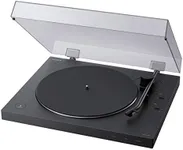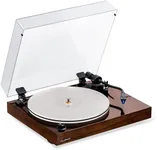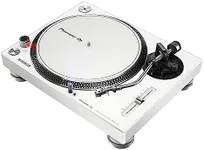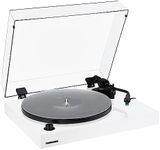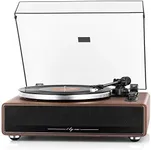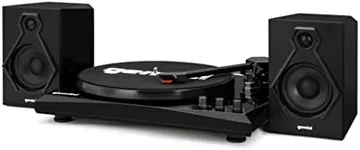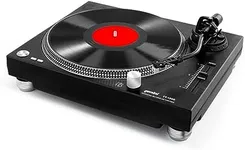Buying Guide for the Best Budget Turntables
Choosing the right turntable can greatly enhance your vinyl listening experience. When selecting a turntable, it's important to consider several key specifications that will impact the sound quality, ease of use, and overall enjoyment. Understanding these specs will help you make an informed decision and find the best fit for your needs.Drive TypeThe drive type refers to how the turntable's platter is powered. There are two main types: belt-drive and direct-drive. Belt-drive turntables use an elastic belt to spin the platter, which helps reduce motor noise and vibration, making them ideal for home listening. Direct-drive turntables have the motor directly connected to the platter, providing more consistent speed and torque, which is preferred by DJs for scratching and mixing. If you are a casual listener, a belt-drive turntable is likely the best choice. If you plan to use the turntable for DJing, a direct-drive model may be more suitable.
Cartridge TypeThe cartridge is the component that holds the stylus (needle) and converts the grooves in the vinyl into an audio signal. There are two main types: moving magnet (MM) and moving coil (MC). MM cartridges are more common, easier to replace, and generally more affordable, making them a good choice for beginners. MC cartridges can offer higher fidelity and detail but are typically more expensive and require a compatible phono preamp. For most users, an MM cartridge will provide excellent sound quality and ease of use.
Platter MaterialThe platter is the part of the turntable that the record sits on. Platter materials can vary, with common options including plastic, aluminum, and acrylic. Plastic platters are lightweight and affordable but may not provide the best sound quality. Aluminum platters are more durable and offer better sound isolation, reducing vibrations. Acrylic platters are considered high-end and provide excellent sound quality by minimizing resonance. If you are looking for a balance between cost and performance, an aluminum platter is a good choice. For audiophiles seeking the best sound quality, an acrylic platter may be worth the investment.
Tonearm TypeThe tonearm is the part of the turntable that holds the cartridge and stylus. There are two main types: straight and S-shaped. Straight tonearms are simpler and often found on entry-level turntables, providing reliable performance for casual listening. S-shaped tonearms are designed to reduce tracking error and can offer better sound quality, making them popular among audiophiles. If you are new to vinyl or looking for a straightforward setup, a straight tonearm will suffice. If you are more experienced or seeking higher fidelity, an S-shaped tonearm may be preferable.
Speed SettingsTurntables typically offer different speed settings to accommodate various types of records. The most common speeds are 33 1/3 RPM (revolutions per minute) for LPs and 45 RPM for singles. Some turntables also support 78 RPM for older shellac records. It's important to choose a turntable that supports the speeds of the records you own or plan to purchase. For most users, a turntable with 33 1/3 and 45 RPM settings will cover the majority of modern vinyl collections. If you have or plan to collect older 78 RPM records, ensure the turntable supports this speed as well.
Built-in PreampA preamp amplifies the signal from the turntable to a level that can be processed by speakers or an amplifier. Some turntables come with a built-in preamp, which simplifies setup and allows you to connect directly to powered speakers or a standard audio system. If your audio system does not have a phono input, a built-in preamp can be very convenient. However, if you already have a high-quality external preamp or plan to upgrade in the future, you may prefer a turntable without a built-in preamp for more flexibility.
